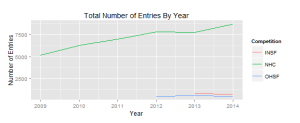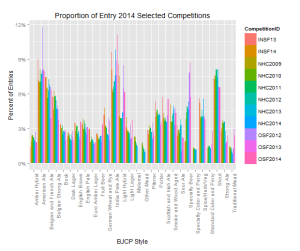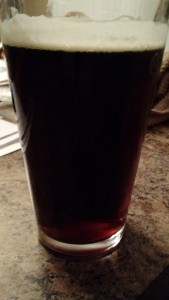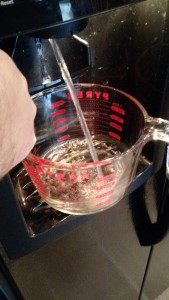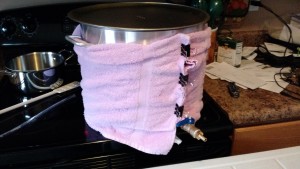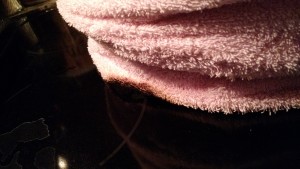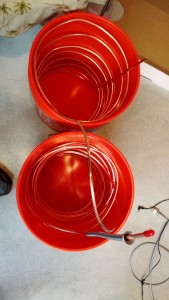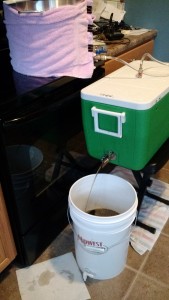Tag Archive: amber ale
Looking at Beer Competitions
I looked into a few homebrewing competitions. I think I mostly wanted to look at how big the categories are.
Data
The data I found is from the National Homebrewing Competition, the Indiana State Fair, and the Ohio State Fair. Only partial datasets were used from the state fairs, because not all the data I need is on their websites. This data is far from perfect, but I think the conclusions I make below are still valid.
Growth
As shown above, there has been a lot of growth in the National Homebrew Competition. From 2009 to 2012, it grew by 50% and by 2014 it grew even more. The states did not show any growth. We’re in a golden age of homebrewing where the Internet helps new homebrewers along, a craft beer surge that shows everyone that not all beer is a Light American Lager. I think this has helped increase the NHC.
Bud’s crack on craft brewing will likely help homebrewing as well as craft beer. After all, 44% of drinkers age 21-27 have never tasted it. Not sure if they’ve had a craft beer either, though (they could be wine or whiskey drinkers).
Styles
I visually looked through to see the top five and bottom five. I didn’t do any actual analysis other than that.
Top 5: American Ale, IPA, Stout, Belgian and French, and Belgian Strong
It is probably expected that American Ales and IPAs would be big styles. I think a lot of people that ‘stick their foot in’ to craft beer start with amber or pale ales and probably soon make it to IPAs. After being in the hobby for 6 months, I’m not shocked to see strong numbers from Stout – it seems like the non-hop-head craft beer lovers gravitate towards good stouts. Also, Stout allows for some flexibility with ingredients without becoming something not-beer. I’m also not shocked to see Belgian and French, and Belgian Strong classes represented well, as many of the homebrewers I know have a profound interest in those two classes (specifically in saisons, tripels, and quadrupels).
Bottom 5: Amber Hybrid, Strong Ale, Sour Ale, Euro Amber Lager, and Dark Lager
Amber Hybrid (which includes Northern German Altbier, Dusseldorf Altbier, and California Common) is one I would have expected to be higher, although that is mostly because of the California Common style. BYO Magazine recently did a feature article on this, perhaps we’ll see some growth there. As far as altbier, I’m not sure my three local bottle shops have any altbier that would be within these styles. I don’t know about others, but I’d sure be apprehensive of brewing a style I’ve never tasted.
Strong Ale was a little shocking. I expected more people to use barleywine to show off malt selection.
I didn’t think it was shocking that sour ale was among the bottom, but maybe that’s because I find them intimidating from the brewing standpoint.
I was shocked to see both the Euro Amber Lager and Dark Lager among the bottom five. These two style groups include some of my favorites in the lager kingdom, Oktoberfest and Schwarzbier.
From my point of view on one of the hills east of Cincinnati, though, I am partially not shocked about all but one of the bottom 5 being lagers. According to the temperature on my ale pail, fermentation holds around 64-66 degrees (Fahrenheit, 18-19 Celcius) in my basement with no temperature control. Perfect for ales, not so much for lagers. I eventually will brew some lagers, but I have to have better temperature control first.
An interesting contrast in the styles is the light hybrid group. Apparently this is pretty common in the midwest, but not nationally – it’s pretty low for NHC, but pretty high for both the state fairs. This includes cream ale, blonde ale, Kolsch, and american wheat or rye. My only guess here is that we have a local soft spot for Little King’s Cream Ale.
Growth and Losses
I looked at this by looking at the slope of the trend based on the NHC data.
The biggest growth style classes are IPA, American Ale, Stout, Belgian and French Ale, and Spice, Herb, and Vegetable Beer. I don’t find any of these shocking except the spice, herb, and vegetable class.
The losing classes are all meads. I’m not sure what to think of that. On one hand, it isn’t uncommon to find a homebrewer that is at least interested in fermenting mead. On the other hand, good honey is incredibly expensive, and that may factor into things.
The not-really-growing classes are Pilsner, Specialty Cider & Perry, German Wheat & Rye, Light Lager, and Standard Cider & Perry. Regarding cider and light lager, I’m not shocked. While I don’t think the hobby is bent against ciders, perries, and light lagers, I think there is a segment of beer drinkers that look on those three groups as being inferior. I don’t agree with them (and I have a cider experiment going on in the basement now), but I think it exists.
That leaves Pilsner and German Wheat & Rye as the odd men out. I’m not sure why, as every beer geek worth his (or her) glass knows that Pilsner is different from Light Lager (and generally regarded as far better). Perhaps it has to do with the difficulty in water chemistry and fermenting. Regarding German Wheat and Rye, I don’t know. It’s not among my favorite styles, but that doesn’t really mean anything to others.
So What’s This All Mean?
Nothing. Nada. Jack Shit. I’m a data geek in real life and wanted to look into this. Awards don’t matter, your taste does. Brew what you like, because if you come in from work and look forward to opening another homebrew, you’re doin’ it right.
…but I understand if you still want to win an award (I do). It’s kinda like getting a medal at the end of a (running) race. The medal symbolizes the work that went into training for that event. Similarly, a beer award symbolizes the work put into formulating and executing a recipe.
Cheers!
Radio Red Ale
I brewed my best beer so far – a subtly hoppy amber ale. This is the beer I’m going to enter into the Cincinnati Malt Infusers competition. It came out well – I can’t stop drinking it, and I can’t stop thinking about different things I want to try with the recipe. Of course I need to brew more of this as I can’t stop grabbing it out of the fridge.
Recipe
Recipe Details
| Batch Size | Boil Time | IBU | SRM | Est. OG | Est. FG | ABV |
|---|---|---|---|---|---|---|
| 5 gal | 60 min | 36.5 IBUs | 13.0 SRM | 1.058 | 1.016 | 5.5 % |
| Actuals | 1.046 | 1.01 | 4.7 % | |||
Style Details
| Name | Cat. | OG Range | FG Range | IBU | SRM | Carb | ABV |
|---|---|---|---|---|---|---|---|
| American Amber Ale | 6 B | 1.045 - 1.056 | 1.01 - 1.015 | 20 - 40 | 11 - 18 | 2.3 - 2.8 | 4.5 - 5.7 % |
Fermentables
| Name | Amount | % |
|---|---|---|
| Pale Malt (2 Row) US | 10 lbs | 88.89 |
| Caramel/Crystal Malt - 40L | 1 lbs | 8.89 |
| Roasted Barley | 4 oz | 2.22 |
Hops
| Name | Amount | Time | Use | Form | Alpha % |
|---|---|---|---|---|---|
| Centennial | 0.75 oz | 60 min | Boil | Pellet | 9 |
| Centennial | 1 oz | 15 min | Boil | Pellet | 9 |
| Citra | 1 oz | 7 days | Dry Hop | Pellet | 12 |
Yeast
| Name | Lab | Attenuation | Temperature |
|---|---|---|---|
| American Ale (1056) | Wyeast Labs | 75% | 60°F - 72°F |
Mash
| Step | Temperature | Time |
|---|---|---|
| Mash In | 156°F | 88 min |
Download
| Download this recipe's BeerXML file |
Recipe licensed under the Creative Commons “by-nc” license.
Taste and Stuff
I love the flavor. I love the citrus hop flavor coming through. The beer has a great head and lacing. My only concern (from a competition standpoint) is the color is a little darker than I expected, and I think I will get dinged for it. I am very happy with the clarity of the beer, though, as my second brew and only partial mash beer was an IPA that tasted great but was very cloudy. This is pretty clear.
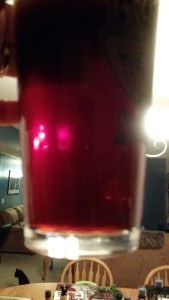
Not the greatest picture artistically, but good to show the clarity and color. It does have a red hue.
Prost!
Beast of a Brew Day
I decided to brew an amber ale last weekend. Brew day started a little late because of family stuff, and it went later because of brewing stuff.
First off, I have water issues. Not dirty issues, chlorine issues. Because of that, my brewing water comes from my refrigerator as de-chlorinated cold water at around 40 degrees. I also had to do a few things related to my boiling bucket, because I really don’t like the idea of lifting 5-6 gallons (40-50 pounds) of hot water and trying to control it. And siphoning? FORGET ABOUT IT. I found that my auto-siphon bends in boiling water. So I added a valve.
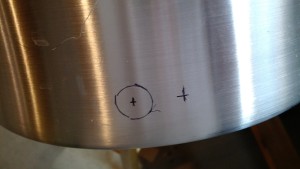
Locate twice, drill once. I nearly put it at the wrong spot, but before drilling I stopped and stood back to look and realized I wanted to go an inch to the right.
I pulled both my strike and sparge water and put them in clean ale pails before leaving for the hardware store for a valve and a cooling solution. The valve is temporary, and it even leaks, so I’m not going to show it. I’m going to order a three-part valve soon.
The Boil
The boil was long. Well, not long to boil, long to bring to a boil. I’m pushing the limit of my stove.
I used the recommendation of using a towel or blanket to keep the heat in. This made a little difference, but not enough. And it isn’t a great solution, as in the process of moving stuff around, I ended up with the following picture:
After waiting bloody-hell forever for boil to start and giving it the hour to boil, it was time to cool.
Cooling
The cooling solution sucks. I bought 1/4″ refrigerator line that I thought I’d run the wort through on it’s way to the ale pail. I figured I’d send the wort through two buckets, one with tap-cold water and the other with ice cold water.
I ran in to two problems. The first is that sanitizer in 1/4″ copper line can freeze. At least, I think that’s what happened. The other is it takes FOREVER to drain the bucket. It brought the wort down to 50F (20+ degrees below pitch temperature), although initially, some of the wort was as low as 34 degrees. It took a few hours to drain the bucket. This is not a good solution.
RDWHAHB
This was one week ago. Yesterday, prior to dry hopping, I tasted the beer from the fermenter (and tested gravity, although since dry hopping may cause additional fermentation it is an unnecessary measurement). I am VERY pleased with the flavor so far, so I think the ounce of Citra hops I threw in there will make it nearly perfect.
Regrouping
I was initially going to do another brew this weekend because January is a busy month for me. I decided that now is not the time, which means I will run out of my Left Coast IPA. That is a tragedy (I really do love IPAs), but I’ll survive, especially with that amber ale coming. I’ve decided that I need to make significant headwind at making Batavia Basement Brewing Company actually be in the basement. This means a heating element, temperature controller, water filter (this is in the works, and wife approved), and some two-phase electrical work.
Prost!
